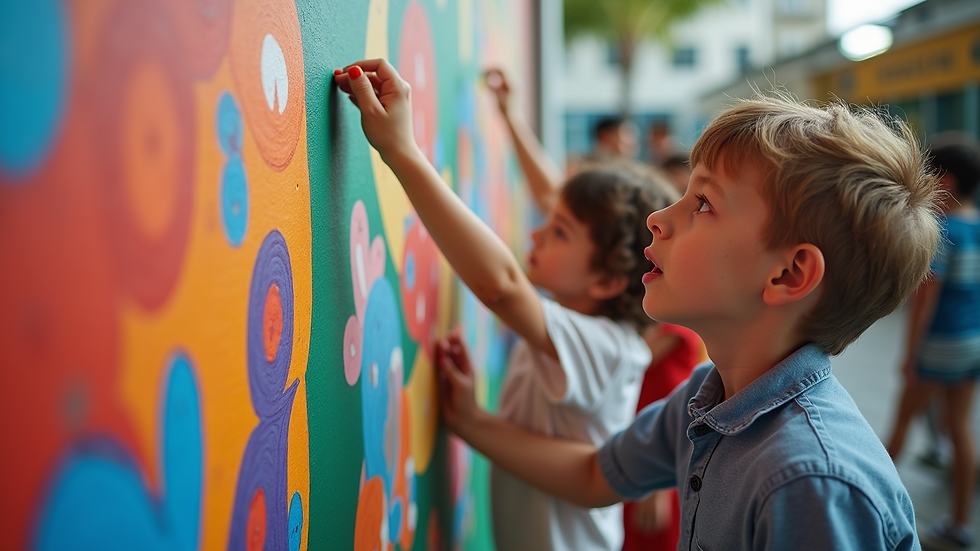- 意言社 Artistori
- 2 days ago
- 4 min read
Painting is a wonderful form of expression that allows individuals to convey emotions, tell stories, and explore their creativity. Whether you are a complete novice or a seasoned artist, guided art lessons can provide you with the skills and confidence to create beautiful artwork. In this blog post, we'll explore the benefits of guided art lessons, the types of painting you can learn, and resources available for those interested in enhancing their artistic journey.
The Benefits of Guided Art Lessons
Guided art lessons offer numerous advantages for individuals of all skill levels. One of the primary benefits is the structured approach to learning. With a qualified instructor, you can receive personalized feedback on your techniques and progress. This guidance allows you to build a strong foundation in your painting skills.
Another significant advantage is the sense of community that comes with taking guided art lessons. Classes often foster an environment where aspiring artists can share ideas, collaborate, and support one another. This communal aspect can inspire creativity and enhance the overall learning experience, making painting not just a solitary activity, but a shared joy.
Additionally, guided art lessons can help reduce the intimidation factor many people feel when starting to paint. Many newcomers worry about making mistakes or not being "good enough." A supportive instructor can help alleviate these concerns by encouraging exploration and experimentation without the pressure of perfection.

Exploring Different Techniques in Art Lessons
When enrolling in guided art lessons, you'll likely encounter a variety of painting techniques. Each technique offers unique challenges and rewards, allowing you to discover your personal style.
Watercolor: This medium is known for its transparency and fluidity. Watercolor techniques often include wet-on-wet, dry brush, and glazing. In guided lessons, instructors may demonstrate how to create soft washes and vibrant blends, helping you create stunning landscapes or abstract pieces.
Acrylic: Acrylic paint is versatile and can mimic both watercolor and oil paint. In guided art lessons, you might learn techniques such as layering, impasto, or stippling. Acrylics dry quickly, allowing painters to work in layers and explore texture.
Oil Painting: Known for its rich colors and texture, oil painting requires different techniques such as blending, glazing, and scumbling. Guided lessons in oil painting can help you understand color mixing and the slow drying time, which allows for greater manipulation of the paint.
By experimenting with these different styles and techniques, you’ll not only build your skill set but also determine which mediums resonate with you the most.

What Kind of Art is Popular in Singapore?
Singapore has a vibrant and diverse art scene, showcasing a mix of traditional and contemporary styles. Among the popular forms of art, you will find:
Contemporary Art: Artists in Singapore often experiment with new techniques and digital media. Many galleries showcase contemporary pieces that challenge traditional norms.
Local Heritage Art: Artists frequently draw inspiration from Singapore's history and culture, creating works that reflect local stories or traditional craftsmanship. This type of art is celebrated in various festivals and exhibitions across the nation.
Street Art: The vibrant streets of Singapore feature impressive murals and graffiti. Artists use public spaces to express their creativity, making art accessible to everyone.
If you're interested in exploring these art forms further, consider enrolling in art classes at Artistori. Not only will you gain insights into local styles, but you'll also have the opportunity to learn from skilled instructors who can guide you through your artistic journey.

How to Choose the Right Art Lessons for You
When selecting guided art lessons, it’s essential to consider a few factors to ensure you find the right fit for your artistic needs. Here are some tips to help you choose:
Identify Your Goals: What do you hope to achieve through these lessons? Whether it's mastering a specific technique, painting for relaxation, or preparing for a career in art, knowing your goals will help you focus on classes that align with your interests.
Research Instructors: Look for instructors with experience and a teaching style that resonates with you. Don’t hesitate to reach out to potential instructors to inquire about their methods and class structure.
Check Class Sizes: Smaller class sizes often provide more personalized attention, which can be particularly beneficial for beginners. Inquire about the maximum number of students per class.
Assess Materials Provided: Some art lessons may provide all necessary materials, while others may require you to bring your own supplies. Be sure to know what you’ll need and whether the class accommodates beginners in this regard.
Trial Classes: If possible, attend a trial class before committing to a full course. This experience will give you a feel for the instructor's teaching style, the class atmosphere, and your comfort level with the medium.
By taking the time to evaluate these aspects, you can make an informed decision and embark on a fulfilling artistic journey.
Embrace Your Creativity Through Guided Art Lessons
As you embark on your painting journey, remember that the most important aspect is to enjoy the process. Guided art lessons can provide you with not only valuable skills but also a deeper appreciation for the creativity and expression found in art. Whether you’re painting landscapes, portraits, or abstract pieces, each stroke of the brush brings you closer to discovering your personal artistic style.
Embrace the joy of painting. Sign up for a guided art lessons at Artistori today and let your creativity flow onto the canvas!







